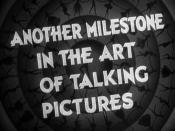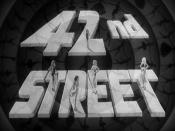42nd Street (1933) is the classic, fast paced, backstage movie musical a refreshing film musical forever and saved Warner Bros. It saved the studios from bankruptcy, helping it grow into a major studio. Set during the Depression and about the Depression, the film is considered the backstage musical par excellence, the grand daddy of them all. It was based on putting on a show tradition stemming from MGM's first sound film, The Broadway Melody, another "backstage musical".
Lloyd Bacon provided its skillful director, with a funny, often-sardonic screenplay by Rian James and James Seymour. The film was nominated for Best Picture. The film succeeded by mixing veteran stars, and exotic chorus girls in abundance. 42nd Street was the first of three landmark musical film released in 1933 by Warner Bros. to revitalize the musical film genre In contrast to fantasy, escapist romantic dance musicals of Fred Astaire and Ginger Rodgers that also began in the same year (Flying Down to Rio (1933)).
The film was an unbelievable look at the tough realities of backstage life behind the footlights. The urban milieu of the film is filled with crisp, slangy, bitter dialogue and wisecracks, streetwise characters, topical references, desperately striving chorines, dancers, crew, and down and out references to the Depression.
After the credits and the brief introduction of charters, the film opens with a shaky aerial view of mid town Manhattan, presumably near 42nd Street. As car horns honk and the sounds of the elevated and other traffic fill the soundtrack, full frame close-ups appear of street corner signs along 42nd Street all way to Times Square. The image dissolves into a view of a theatrical agent hanging up a phone call and exclaiming: Okay say, Jones and Barry are doing a show! The exciting news alert is passed...

